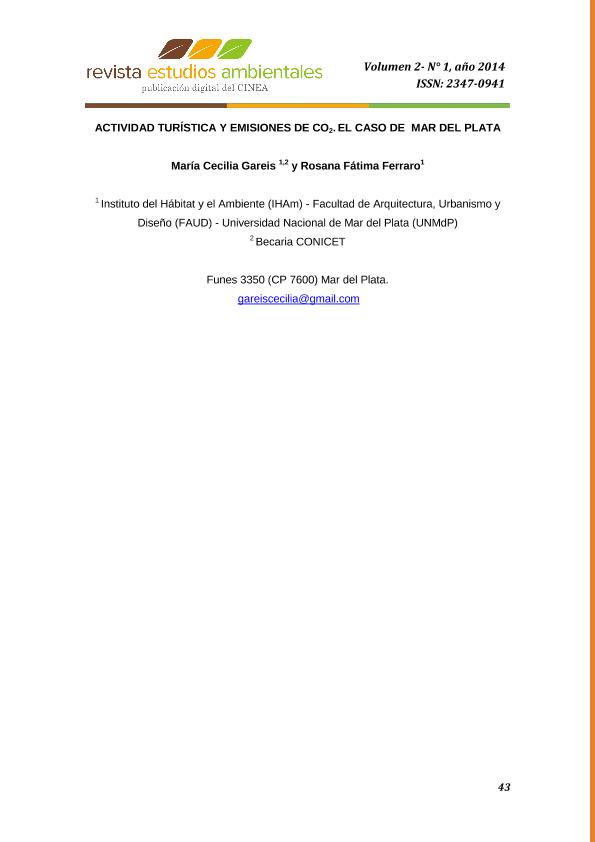Artículo
La ciudad de Mar del Plata, cabecera del partido de General Pueyrredon, posee un marcado perfil turístico que constituye uno de los principales centros de veraneo del país al brindar, además de sus recursos naturales, un amplio abanico de actividades relacionadas al ocio y la recreación. En términos poblacionales ocupa el octavo lugar dentro de los 15 aglomerados urbanos de mayor tamaño de Argentina (Ferraro et al., 2013) al albergar a 618.989 habitantes estables (INDEC, 2010). Esta característica de estacionalidad en la cantidad de población también supone una estacionalidad en la demanda de energías y materiales para satisfacer sus necesidades, por lo tanto conocer cómo varían dichas demandas es de relevancia si se considera que el partido no produce energía localmente y la importa en sus diferentes formas. En este contexto, el turismo incide sobre el consumo energético ya que incrementa el número de personas y por ende la demanda de bienes y servicios. El presente trabajo tiene como objetivo estimar los consumos de combustibles comercializados por mayoristas y minoristas en el partido de General Pueyrredon, según su variación a lo largo del año, analizando las emisiones de CO2 generadas por el uso de éstos durante el año 2010. Los resultados muestran que existe una relación entre los picos de consumo de combustibles y los meses de mayor actividad turística; asimismo los datos revelan que el principal combustible utilizado fue el GNC, sin embargo, las mayores emisiones tuvieron como fuente principal el uso de gas oil; en tanto que de todos los sectores, el sector al público resultó el de mayor demanda. Mar del Plata, as county seat of partido of General Pueyrredon, has a strong touristic profile andit constitutes one of the main summer places in the country since it provides, apart from its many natural resources, a wide range of recreational and leisure activities. In populational terms, the city occupies the 8th place among the 15 largest urban areas in Argentina (Ferraro et al, 2013) with 618.989 stable inhabitants (INDEC, 2010). This quality of seasonality in the number of inhabitants assumes the same seasonal characteristic in the demand of energy and materials in order to satisfy their needs. For this reason, knowing how such demands vary is of prime importance considering that the partido does not produce its own energy locally but imports it in different forms. In this context, tourism affects the energetic consumption in that the number of people increases and with it the demand of goods and servicesincreases as well.This paper aims to estimate the consumption of fuels commercialized by wholesale suppliers and retailers in partido of General Pueyrredonaccording to the variation throughout the year by analyzing CO2emissions produced by the use of fuel during 2010.The results show that there is a relation between the peak fuel consumption and the months with the most touristic activity; the results also reveal that the main fuel type used was CNG, however the greatest emissions were produced by the use of gas oil; of all the sectors, the retail sector was the one with the highest demand.
Actividad turística y emisiones de CO2. El caso de Mar del Plata
Fecha de publicación:
08/2014
Editorial:
Centro de Investigaciones y Estudios Ambientales
Revista:
Revista Estudios Ambientales
ISSN:
2347-0941
Idioma:
Español
Tipo de recurso:
Artículo publicado
Clasificación temática:
Resumen
Palabras clave:
Aglomerado Urbano
,
Demanda Energética
,
Combustibles
Archivos asociados
Licencia
Identificadores
Colecciones
Articulos(CCT - MAR DEL PLATA)
Articulos de CTRO.CIENTIFICO TECNOL.CONICET - MAR DEL PLATA
Articulos de CTRO.CIENTIFICO TECNOL.CONICET - MAR DEL PLATA
Citación
Gareis, María Cecilia; Ferraro, Rosana Fatima; Actividad turística y emisiones de CO2. El caso de Mar del Plata; Centro de Investigaciones y Estudios Ambientales; Revista Estudios Ambientales; 2; 1; 8-2014; 43-58
Compartir




